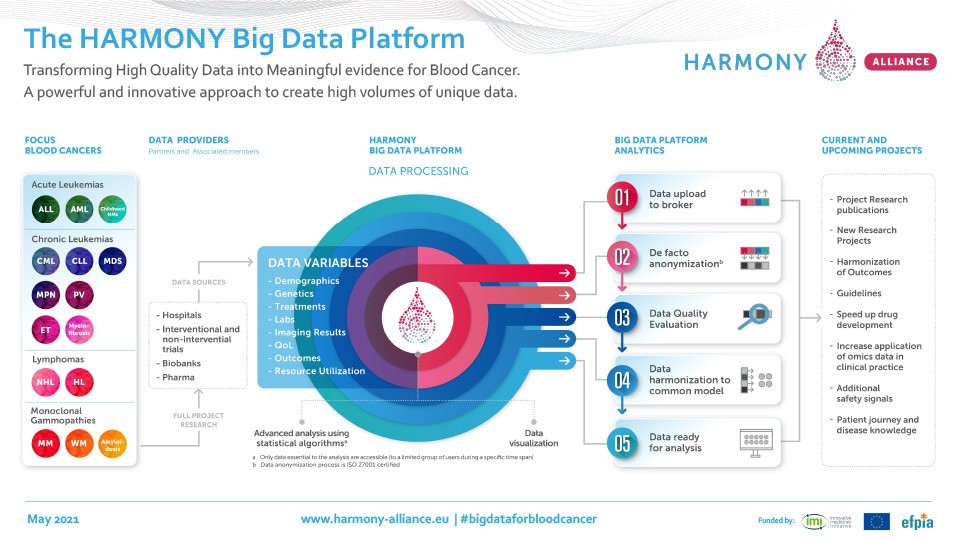The Harmony Alliance creates the first European map of hematologic neoplasms applying big data and artificial intelligence

In conjunction with World Myelodysplastic Syndromes (MDS) Day, the HARMONY Alliance highlights the progress made in this field through the collaboration of European public centers and pharmaceutical laboratories. The Alliance is comprised of the HARMONY and HARMONY PLUS projects, formalized within the framework of the European Union’s Innovative Medicines Initiative (IMI).
Five years into the project, nearly 12,000 MDS patient data have been collected, of 40% of which have come from the database of the Spanish Myelodysplastic Syndromes Group (GESMD), the largest registry of MDS patients in Spain, which chares the vision and values of the HARMONY Alliance.
Leveraging this extraordinary volume of data leads to the generation of new knowledge, thanks to the capabilities of digital tools such as big data or new artificial intelligence (AI) techniques to improve the analytical capacity and increase precision in research. A clear example is the research project to determine prognostic factors that help identify patients with MDS who are most likely to respond to treatment with hypomethylating agents, as well as experiencing a prolonged response duration. The same analysis is conducted for high-risk patients who can receive intensive chemotherapy. But it is not the only one. The Alliance has a significant portfolio of research projects in at a variety of stages of development in other blood-related diseases.
Lead by two Spaniards, Doctor Jesús María Hernández, specialist from the Hematology service at the University Hospital in Salamanca, and Doctor Guillermo Sanz, Clinical Hematology Section Chief at La Fe University Hospital in Valencia, the HARMONY Alliance encompasses the research efforts of over 150 experts in hematologic neoplasms, from more than 80 public-private organizations in 18 European countries.
The pan-European health research hub was revalidated by the European authorities with the approval of the HARMONY PLUS project in October 2020. This second project extends the scope of action of the Alliance to all hematologic neoplasms and studies the blood diseases not included in the HARMONY project, such as myeloproliferative neoplasms (MPN)–including chronic myeloid leukemia (CML), polycythemia vera (PV), essential thrombocythemia (ET), and myelofibrosis (MF)–, lymphoproliferative disorders, including Hodgkin lymphoma (HL), Waldenström's macroglobulinemia, and others. GMV, as the project’s technology partner, revalidates the trust of the Alliance to accelerate, through the use of big data, the development of more effective treatments for the clinical approach to patients with blood cancers.
First European map of blood tumors
As Dr. Sanz explains, “with the HARMONY big data platform developed by GMV, Alliance researchers can draw the first European map of blood tumors, using the harmonization of shared data, guaranteeing the protection and privacy of patients at all times.”
The end goal of the HARMONY Alliance is to reduce the development and market times for new treatments and innovative medicines, to apply precision medicine and move forward toward achieving personalized therapies. “We have achieved a sufficiently broad sample that includes cases from throughout Europe, which we can use to extract the necessary clinical evidence,” says Hernández, coordinator of the HARMONY consortium. Dr. Sanz, the co-coordinator, also says that “this initiative will facilitate decision-making at the health and care policy level to offer more effective and safer treatments.” According to Inmaculada Pérez Garro, GMV’s Digital Health Director, digital technology has played a very relevant role in all of this, as “we have been able to guarantee observance of all legislation protecting personal health information and extract extraordinary amounts of information that, without these technologies, would have been impossible to manage.”
Dr. Hernández points out that “to put together the sample we needed to ensure our research offered conclusive results, we undertook a titanic negotiation effort, bringing together all stakeholders involved in treating blood diseases: patient associations, academic institutions, hospitals, the pharmaceutical industry, regulators, evaluators, and healthcare technology companies. With that, we have been able to collect data on over 80,000 patients with different hematologic neoplasms, including the nearly 12,000 related to MDS patients.”
The HARMONY Alliance also seeks to cross European borders and extend the study period: blood diseases are very diverse and some of them require follow-up in excess of 15 years. “We are achieving this in our myeloma database, with an average follow-up of 10 years, making it a unique series,” says Dr. Hernández Rivas. At the same time, “if in the coming years we were able to get the EMA to accept studies like the ones we are conducting in the HARMONY Alliance, it would enable us to conduct trials with new drugs in a single branch that could be compared with the standard, streamlining the availability of new drugs,” Dr. Sanz concludes.
The Alliance is applying advanced analytical technologies, big data and artificial intelligence, developed by GMV, to draw the first European map of blood tumors.